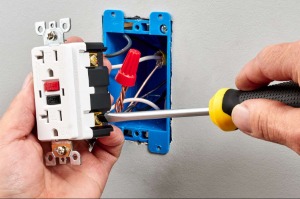
Maybe you want to replace or install a new gfci outlet in your bathroom or kitchen. Wiring a gfci receptacle is an easy task for electricians and diy lovers with wiring experience.
However, you must meet all safety standards and the national electrical code requirement to keep your bathroom safe.
In this blog post, I will guide you on how to install gfci outlets in your bathrooms, kitchens and entire home.
What is a gfci outlet?
A GFCI (Ground Fault Circuit Interrupter) is a type of electrical outlet designed to protect you from electric shock. The outlet works by monitoring the current flow in the circuit.
When it detects an imbalance between the current going to and returning from the outlet, it cuts off the circuit.This type of receptacle is often used in areas where ground faults are common.
How does GFCI outlet work?
The primary function of a gfci outlet is to protect human beings from electrical shocks.
It achieves that by monitoring the flow of electricity between the line and load terminals of the outlet.
If it detects an imbalance between the line and load terminals, it trips the circuit to prevent electrical hazard.
Where is it required?
GFCIs are required by the NEC to be mounted in areas with a higher risk of electric shock, such as bathrooms, kitchens, garages, and outdoor wet areas.The receptacles are required to be placed within 2 to 4 feet of the wall.
Materials and tools required for the installation
The following materials and tools are necessary to wire a gfci outlet.
- GFCI receptacle
- Non-contact voltage tester
- Screwdriver
- Plier
Procedures to wire the bathroom outlet
Once you have the required tools and materials; put on your protective glove and begin the gfci wiring.
Shut Off the power supply
Before you begin any wiring projects, it’s important to turn off the power source. This ensures that you don’t get electrocuted while handling electrical wires. To turn off the power to the outlet, locate the circuit breaker in your home breaker panel and switch it off.
Remove the wall plate and the old outlet
Now that you turn off the electrical system, loosen the screws holding the wall plate with your screwdriver, and remove the wall plate.
Pull out the existing outlet from the electrical box and disconnect the wiring. Remember how everything was wired before you disconnect it.
Attach the new outlet

The receptacle usually comes with 2 pairs of screw terminals, namely:
- Line terminals: This supplies power to the outlet from the breaker panel
- Load terminals: This supplies power to the devices connected to the outlet.
- Earth terminal: To connect the earth or ground wire
Connect the wires
The brass screws on the outlet are for hot or black wire, while the silver screws are for neutral wires. First, do the line connection. Connect the black and white wires from the breaker box to the brass and silver screw of the line terminals.
Do the same for the load terminals and connect the bare copper wire to the green screw.
Make sure all wires are tight and secure and that no bare wires are exposed.
Put the new gfci back into the outlet box
Once you finish the wire connection, mount the outlet into the wall, cover it and tighten the screws.
Test the GFCI Outlet
Turn on the power and press the test button on the gfci outlet. This will cause the receptacle to trip and shut off power.
Press the reset button to restore power to the outlet. If the circuit breaker doesn’t trip or reset when you press the test or reset button, there may be a problem with the wiring connection.
In this case, turn off the power again and double check your wiring connections, or consider replacing the outlet.
FAQ
Can I install a gfci outlet myself?
Yes, you can mount the receptacle outlet yourself if you have some basic electrical knowledge and the bathroom electrical code
Can a bathroom gfci and light be on the same circuit?
Yes, a bathroom gfci and light can be on the same 20-amp circuit provided the total load on the circuit didn’t exceed the electrical capacity of the circuit.
Related articles